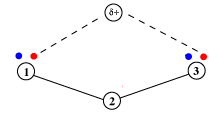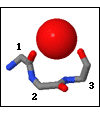Niche
Definition
A motif of three or four consecutive residues in which the main-chain CO of residue-1 and the main-chain CO of the last residue (-3 or -4) have the potential to make weak interactions with a cationic group. The Niches in the database are selected on the criteria of the dihedral angles defining the sub-categories (below).

4-Residue (2,3,4-αRαRβR) 4-Residue (2,3,4-βRαLβR)
Sub-categories
- 2,3-αRβR (3-residue)
- 2,3-αLβL (3-residue)
- 2,3,4-αRαRβR (4-residue)
- 2,3,4-βRαLβR (4-residue)
Reference
Torrance et al., J. Mol. Biol. 385:1076-1086 (2009)
Comments
1. Niches were originally termed ‘catmats’.
2. The 2,3-αLβL sub-category is the left-handed form of 2,3-αRβR (3-residue), whereas the 2,3,4-βRαLβR sub-category is the 2,3-flipped form of 2,3,4-αRαRβR (4-residue). This restriction in the range of Niches — which differs from the wider range of possibilities we include for H-bonded motifs — is based on our published analysis of which conformations actually bind cations. (For this reason we have dropped a previous sub-category — 2,3,4-αLαLβL — from the database.)
3. The ranges used to define the φ and ψ angles for Niches differ from the defaults listed in the Introduction. In some cases they are narrower, although for the βL conformation they are wider to encompass the observed clustering. For this reason the definition of 2,3-αLβL (3-residue) differs from that used previously.
- αR: φ = –160° to –60°; ψ = –50° to +30° (3-residue Niches)
- αR: φ = –120° to –60°; ψ = –50° to +30° (4-residue Niches)
- βR: φ = –100° to –50°; ψ = +110° to +170°
- βL: φ = +20° to +140°; ψ = +140° through +180° to –100°
Occurrence
About half of the Niches in the database are actually bonded to a positive or δ+ group. Illustrated are a water molecule (the interaction is with the δ+ hydrogen atoms) for a 3-residue right-handed Niche, a calcium ion for a 3-residue left-handed Niche and a 4-residue right-handed Niche, and a sodium ion for a 4-residue flipped Niche.
